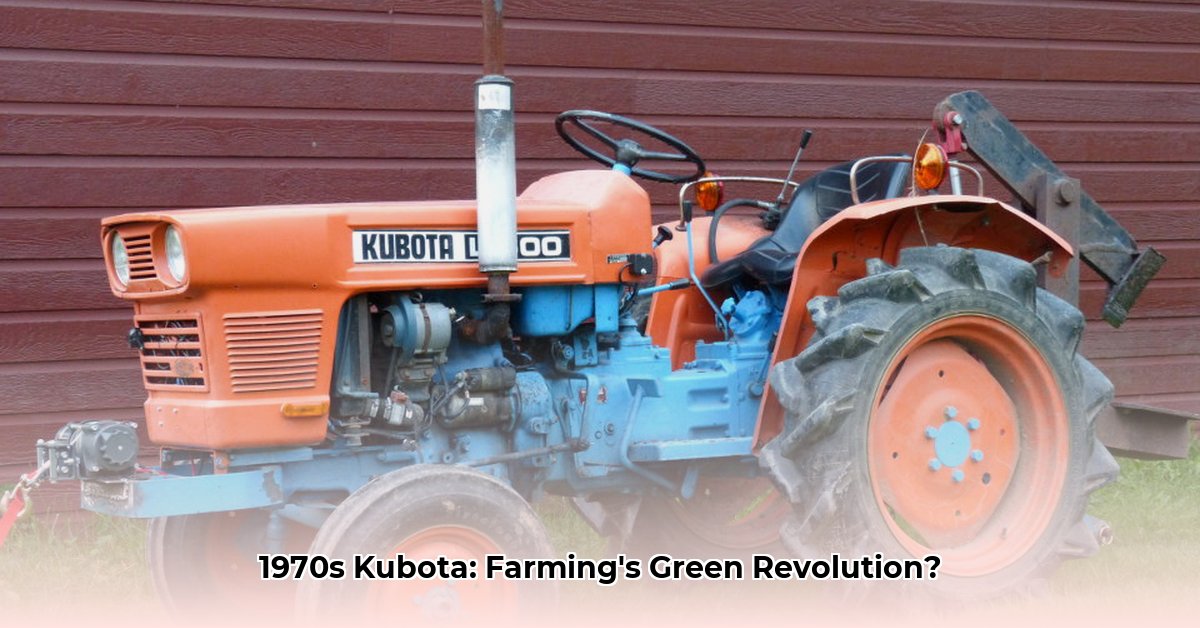
Imagine 1970s Japan: a patchwork quilt of small farms clinging to precious plots of land. Farmers faced a daunting challenge: maximizing yields from limited acreage without depleting resources. Enter the 1970 Kubota tractor – a compact powerhouse that quietly revolutionized sustainable farming practices. This article explores its historical context, technical specifications (where available), and lasting impact on the evolution of sustainable agriculture. To learn more about Kubota's manufacturing, click here: Kubota Manufacturing.
Farming in 1970: A Landscape of Constraints
The agricultural landscape of 1970 presented unique challenges, particularly in Japan. Small, family-run farms were the norm. Large, fuel-intensive tractors were impractical for these smaller plots. Farmers needed efficient, affordable, and maneuverable machinery. The 1970 Kubota tractor directly addressed this pressing need, becoming a symbol of a burgeoning movement toward sustainable agricultural methods. This compact machine represented a paradigm shift, laying the groundwork for future innovations in smarter, resource-conscious farming.
The 1970 Kubota Tractor: Specifications and Impact
Precise specifications for a 1970 Kubota tractor are scarce. Detailed records from that era are often incomplete. However, we know these early models prioritized efficiency over sheer power. Their strength lay not in brute force, but in fuel economy and maneuverability. These tractors likely boasted impressive fuel efficiency for their time, minimizing both environmental impact and operational costs – cornerstones of sustainable farming. The compact size and agility of the Kubota allowed for precise cultivation, minimizing wasted effort and resources, and maximizing yields in smaller plots of land. How did this compact design advance the principles of sustainable farming? By reducing fuel consumption and allowing for more precise work in the field.
Kubota's Evolution: A Legacy of Refinement
The 1970 Kubota marked the beginning of a remarkable evolution. Over the decades, Kubota consistently refined its designs, leading to significant improvements in horsepower, versatility, and fuel efficiency. While precise figures remain elusive for early models, the trajectory is clear: more output with less input. This dramatic improvement underscores the broader advancement of sustainable agricultural practices – maximizing productivity while minimizing environmental impact. This commitment to continuous improvement speaks volumes about Kubota's enduring dedication to progress and sustainability.
Sustainability: A Historical and Ongoing Assessment
Assessing the environmental impact of early Kubota tractors requires careful consideration. Data regarding emissions, material sourcing, and manufacturing processes is limited for this era. Yet, the inherent efficiency of their design, particularly for smaller farms, suggests a reduced environmental footprint compared to larger, less fuel-efficient machines. By minimizing fuel consumption, these tractors likely lowered the overall carbon footprint of farming activities. However, future research is necessary to paint a complete picture. Detailed life-cycle assessments (LCAs) – encompassing manufacturing, use, and disposal – are crucial for a thorough understanding of their long-term environmental impact. This thorough analysis is critical for refining our understanding of the sustainability story of Kubota tractors, both then and now.
Actionable Insights: A Collaborative Path Towards Greener Farming
Sustainable agriculture requires a multi-faceted approach. The following table outlines actionable steps for various stakeholders:
| Stakeholder | Short-Term Actions (0-1 Year) | Long-Term Actions (3-5 Years) |
|---|---|---|
| Kubota Corporation | Conduct thorough LCAs of all current models; enhance transparency in sustainability reporting. | Invest heavily in R&D of electric or hybrid tractors; explore biofuel compatibility; provide detailed environmental data for all products. |
| Agricultural Researchers | Analyze historical data to identify trends in fuel efficiency and sustainability metrics. | Investigate the long-term effect of Kubota tractor evolution on soil health, biodiversity, and carbon sequestration. |
| Farmers | Assess the cost-effectiveness of adopting fuel-efficient and sustainable tractor models. | Explore government incentives and financing options for sustainable agricultural equipment. |
| Governments | Implement stricter emissions standards; encourage the adoption of sustainable farming practices. | Provide substantial subsidies for sustainable agricultural technologies (e.g., electric tractors, precision farming tools). |
Conclusion: A Legacy of Sustainable Innovation
The 1970 Kubota tractor's story transcends mere mechanical innovation. It represents an important chapter in the broader movement towards sustainable agriculture – a response to both economic and environmental pressures. From its compact design to its efficient engine, its legacy continues to shape modern farming practices. The ongoing evolution of Kubota tractors reflects a lasting commitment to progress, innovation, and the pursuit of environmentally responsible food production. The next chapter in this story promises even greater advancements in sustainability.